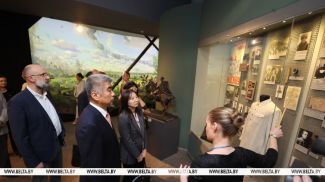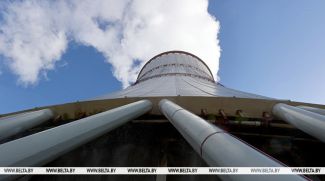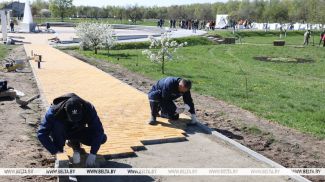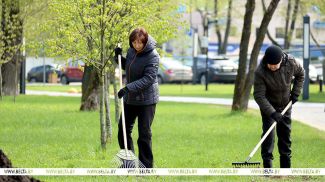Reports about a surgery that relied on a 3D model of the human heart were released by every Belarusian mass medium a short while ago. Heart surgeons were preparing for a complicated surgery using a 3D printed model of the human heart to rule out errors during the actual surgery and to ensure the best possible result and rapid post-hospital rehabilitation. That 3D model was printed in Germany. But now such models can be printed in Belarus to help the local medics. Scientists of the Heat and Mass Transfer Institute of the National Academy of Sciences of Belarus have been able to create a 3D model and print an entire set of models of human organs. Computer tomography has been used to create 3D models of the knee joint and the foot of real patients. Medics have already used the 3D models to prepare for complicated surgeries.
Sergei Filatov, Head of the Lab for Synthesis and Analysis of Micro and Nanosized Materials at the Heat and Mass Transfer Institute of the National Academy of Sciences of Belarus, said: “Medics of the national applied research center for traumatology and orthopedics were preparing for a knee joint surgery. The patient's case was complicated. In order to make sure the surgery will be a success, the medics decided to study peculiarities of this particular joint using the 3D model we could provide. We converted a digital copy of the CT scan into a 3D model and printed it. The surgeons used the print to prepare for the surgery, which went off without a hitch. They contacted us later with a similar request — a complicated case involving human foot. Once again the surgery was successful.”
Seeing a CT scan on a computer screen may not be enough for preparing a complicated surgery. This is why 3D modelling and printing come in handy. A 3D model precisely replicates how the real organ is built and matches the real organ's size. The fact allows surgeons to polish the technology, plan the surgery, and guarantee its success.
At present the Heat and Mass Transfer Institute of the National Academy of Sciences of Belarus uses six dedicated 3D printers. Three of them have been created by the lab. The scientists use special software to process the patient's CT scan and create a unique three-dimensional model of the required organ. After that the model is adjusted, automatically split into thin layers, and printed. The printing operation can take from as little as 1-2 hours to 20 hours depending on the required precision, the material, and the size of the model.
Yevgeny Batyrev, Junior Research Scientist of the Lab for Synthesis and Analysis of Micro and Nanosized Materials at the Heat and Mass Transfer Institute, said: “The windpipe and the hand are made from flexible material — polyurethane. These are test models made to find out possible applications for the new technology and the new materials. More often than not, we use biocompatible plastics such as polylactide (PLA) to make the models. The material conveniently imitates qualities of the real joint, this is why 3D models of the knee joint and the ankle joint fit requirements of the surgeons.”
According to the scientists, in addition to creating models and artificial limbs from plastic and composite materials they are potentially ready to start making tissues with live cells. “We can make 3D models of virtually any organ. The degree of precision is what matters and is determined by medics,” explained Mikhail Dolgikh, Deputy Head of the Lab for Synthesis and Analysis of Micro and Nanosized Materials. “Specialists from different fields have their own vision, their own stereotypes. It is a problem. It is important for our medics and biophysicists to show initiative on their own. We are not waiting for them to contact us now. We constantly develop new bioprinting technologies. We are ready to do the work once they approach us and say what needs to be done.”
The scientists are convinced it is necessary to maintain closer cooperation with medics. In order to create precise 3D models of complicated organs such as the heart a combination of medical knowledge and knowledge about additive technologies is required. “I think we should work on it together. Cooperation is better than anything because everyone is a specialist in his or her own field and joint efforts produce the best results,” stressed Mikhail Dolgikh.
Now the scientists are busy making a multiple-component 3D model of the human heart for medics from the national applied research center for cardiology. An agreement on cooperation with the Belarusian State Medical University is available. The scientists are going to create replicas of vessels out of elastic plastic so that university students could practice their first surgeries on them. 3D printing can produce any educational models and allows learning using visual aids.
A joint project with the Republic of Korea will be discussed next week. The project will involve the production of individualized medications with individualized dosage. “I am talking about personalized 21st century healthcare. It is possible to make medications for a specific individual using a specialized 3D printer. It is a new trend. We intend to work out the technology, technical specifications and documents. We intend to find a Belarusian organization that will agree to hold clinical trials to confirm the technology works. I hope that Belarusian pharmaceutical companies will take interest in our R&D product. We will hand over the technology to a company that will take care of making medications,” Sergei Filatov shared the plans.
The scientists design and print the experimental research equipment that they need, for instance, components for optical systems. It allows satisfying needs of the lab in addition to saving time, money, and effort. The specialists assembled the institute's first 3D printer with their own hands four years ago.
Nowadays scientists of the Heat and Mass Transfer Institute of the National Academy of Sciences of Belarus carry out research projects that can benefit not only healthcare and education. The additive technologies they work with can be used by the production sector, too. 3D printing can create complicated forms and structures faster and cheaper than conventional technology. Cutting-edge additive technologies offer unlimited capabilities for designing and creating new systems with optimal parameters. The scientists are convinced that all the prerequisites for developing these technologies in various branches of the national economy are available in Belarus.











